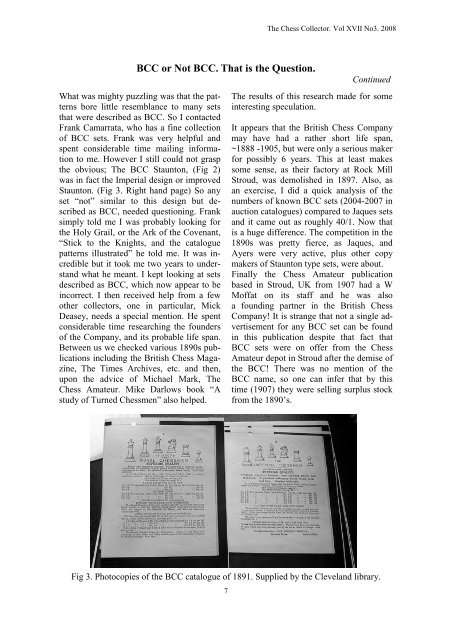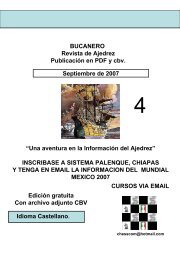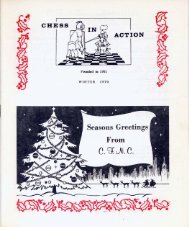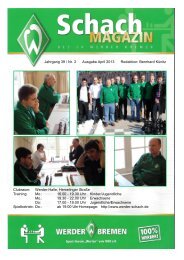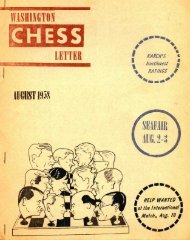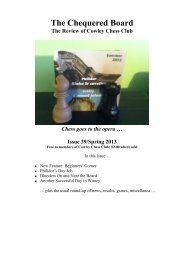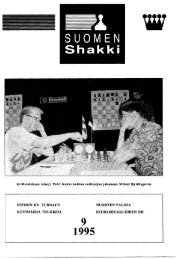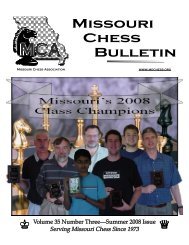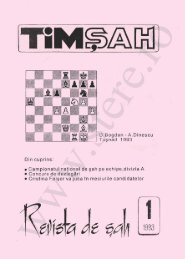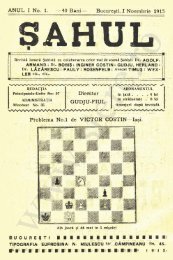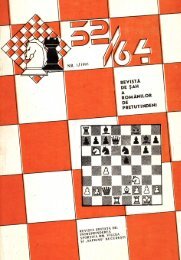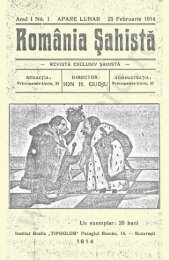The Chess Collector
El ajedrez es un juego, considerado un deporte, entre dos personas, cada una de las cuales dispone de 16 piezas móviles que se colocan sobre un tablero dividido en 64 escaques. En su versión de competición está considerado como un deporte.
El ajedrez es un juego, considerado un deporte, entre dos personas, cada una de las cuales dispone de 16 piezas móviles que se colocan sobre un tablero dividido en 64 escaques. En su versión de competición está considerado como un deporte.
You also want an ePaper? Increase the reach of your titles
YUMPU automatically turns print PDFs into web optimized ePapers that Google loves.
<strong>The</strong> <strong>Chess</strong> <strong>Collector</strong>. Vol XVII No3. 2008<br />
BCC or Not BCC. That is the Question.<br />
What was mighty puzzling was that the patterns<br />
bore little resemblance to many sets<br />
that were described as BCC. So I contacted<br />
Frank Camarrata, who has a fine collection<br />
of BCC sets. Frank was very helpful and<br />
spent considerable time mailing information<br />
to me. However I still could not grasp<br />
the obvious; <strong>The</strong> BCC Staunton, (Fig 2)<br />
was in fact the Imperial design or improved<br />
Staunton. (Fig 3. Right hand page) So any<br />
set “not” similar to this design but described<br />
as BCC, needed questioning. Frank<br />
simply told me I was probably looking for<br />
the Holy Grail, or the Ark of the Covenant,<br />
“Stick to the Knights, and the catalogue<br />
patterns illustrated” he told me. It was incredible<br />
but it took me two years to understand<br />
what he meant. I kept looking at sets<br />
described as BCC, which now appear to be<br />
incorrect. I then received help from a few<br />
other collectors, one in particular, Mick<br />
Deasey, needs a special mention. He spent<br />
considerable time researching the founders<br />
of the Company, and its probable life span.<br />
Between us we checked various 1890s publications<br />
including the British <strong>Chess</strong> Magazine,<br />
<strong>The</strong> Times Archives, etc. and then,<br />
upon the advice of Michael Mark, <strong>The</strong><br />
<strong>Chess</strong> Amateur. Mike Darlows book “A<br />
study of Turned <strong>Chess</strong>men” also helped.<br />
Continued<br />
<strong>The</strong> results of this research made for some<br />
interesting speculation.<br />
It appears that the British <strong>Chess</strong> Company<br />
may have had a rather short life span,<br />
~1888 -1905, but were only a serious maker<br />
for possibly 6 years. This at least makes<br />
some sense, as their factory at Rock Mill<br />
Stroud, was demolished in 1897. Also, as<br />
an exercise, I did a quick analysis of the<br />
numbers of known BCC sets (2004-2007 in<br />
auction catalogues) compared to Jaques sets<br />
and it came out as roughly 40/1. Now that<br />
is a huge difference. <strong>The</strong> competition in the<br />
1890s was pretty fierce, as Jaques, and<br />
Ayers were very active, plus other copy<br />
makers of Staunton type sets, were about.<br />
Finally the <strong>Chess</strong> Amateur publication<br />
based in Stroud, UK from 1907 had a W<br />
Moffat on its staff and he was also<br />
a founding partner in the British <strong>Chess</strong><br />
Company! It is strange that not a single advertisement<br />
for any BCC set can be found<br />
in this publication despite that fact that<br />
BCC sets were on offer from the <strong>Chess</strong><br />
Amateur depot in Stroud after the demise of<br />
the BCC! <strong>The</strong>re was no mention of the<br />
BCC name, so one can infer that by this<br />
time (1907) they were selling surplus stock<br />
from the 1890’s.<br />
Fig 3. Photocopies of the BCC catalogue of 1891. Supplied by the Cleveland library.<br />
7


